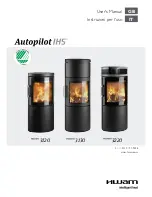
23
Intrepid 1640 Woodburning Stove
30000830
4. Remove the gasket from the channel, place it on a
wood cutting surface, and cut it at the marked spot
with a utility knife. Twist the ends slightly to discour-
age the gasket from unraveling.
5. Lay an unbroken 1/8” (3 mm) bead of gasket cement
in the newly-cleaned channel.
6. Starting at one end, press the gasket into the chan-
nel. Ensure a good joint where the gasket meets be-
fore trimming any excess. Do not overlap the gasket
ends or leave ends with ragged edges.
7. Press the gasketed part firmly against its normal
mating surface to seat the gasket evenly in its chan-
nel. Close and latch the door to do this; close the
door on a piece of waxed paper to keep the cement
from migrating onto the non-gasketed part, or tap
other parts
8. Clean excess cement from around the channel. Let
the cement that holds the new gasket dry thoroughly.
Adjust the Door Latch
Over time, the door latch mechanism may need ad-
justment to compensate for compression of the door
gasketing.
1. Using the 5/32” Allen wrench supplied with the stove,
loosen the Small Locknut enough to extend the
Striker Screw one turn clockwise into the Pawl.
2. Retighten the Small Locknut while keeping the Strik-
er Screw from turning. Test the door latch closure.
You should feel some resistance as you turn the
handle down through the fully closed position. Make
small adjustments as necessary to achieve a secure
latch.
The Chimney System
Creosote
Your Intrepid is designed to reduce creosote buildup
significantly. However, regular chimney inspection and
maintenance must still be performed. For safety, good
stove performance, and to protect your chimney and
chimney connector, inspect your chimney and chimney
connector on a regular schedule. Clean the system if
necessary. Failure to keep the chimney and connector
system clean can result in a serious chimney fire.
When wood is burned slowly, it produces tar,
organic vapors and moisture that combine to form
creosote. The creosote vapors condense in the
relatively cool chimney flue. As a result, creosote
residue accumulates on the flue lining. When
ignited, this creosote makes an extremely hot fire
within the flue system that can damage the chimney
and overheat adjacent combustible material.
If you do have a chimney fire, promptly:
•
Shut off the air supply by placing the Air
Control lever all the way to the left (LOW).
•
Get everyone out of the house.
•
Call the Fire Department.
You should inspect the system every two weeks during
the heating season as part of a regular maintenance
schedule. To inspect the chimney, let the stove cool
completely. Then, using a mirror and a strong light,
sight up through the flue collar into the chimney flue. If it
is not possible to inspect the flue system in this fashion,
the stove must be disconnected to provide better view-
ing access.
If a significant layer of creosote has accumulated
— 1/8” (3 mm) or more — remove it to reduce the risk
of a chimney fire.
Clean the chimney using a brush the same size and
shape as the flue liner. Flexible fiberglass rods are
used to run the brush up and down the liner, causing
any deposits to fall to the bottom of the chimney where
they can be removed through the clean-out door.
The chimney connector should be cleaned by discon-
necting the sections, taking them outside, and removing
any deposits with a stiff wire brush. Reinstall the con-
nector sections after cleaning, being sure to secure the
individual sections with sheet metal screws.
If you cannot inspect or clean the chimney yourself,
contact your local Vermont Castings’ Authorized Dealer
or hire a professional chimney sweep.
ST531
Door Pawl
11/00
Fig. 36
Door Latch Adjustment
Small Locknut
Pawl
Stricker Screw
Large
Locknut
Set Screw
Handle Stub
ST531
f i r e - p a r t s . c o m










































